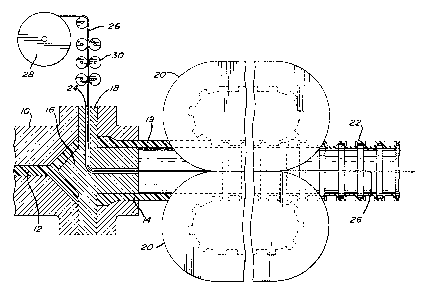Some of the information on this Web page has been provided by external sources. The Government of Canada is not responsible for the accuracy, reliability or currency of the information supplied by external sources. Users wishing to rely upon this information should consult directly with the source of the information. Content provided by external sources is not subject to official languages, privacy and accessibility requirements.
Any discrepancies in the text and image of the Claims and Abstract are due to differing posting times. Text of the Claims and Abstract are posted:
| (12) Patent: | (11) CA 1302310 |
|---|---|
| (21) Application Number: | 1302310 |
| (54) English Title: | PLASTIC CONDUIT WITH INTEGRAL PULL WIRE |
| (54) French Title: | CONDUIT DE PLASTIQUE A CABLE DE TRACTION INTEGRAL |
| Status: | Expired and beyond the Period of Reversal |
| (51) International Patent Classification (IPC): |
|
|---|---|
| (72) Inventors : |
|
| (73) Owners : |
|
| (71) Applicants : |
|
| (74) Agent: | SMART & BIGGAR LP |
| (74) Associate agent: | |
| (45) Issued: | 1992-06-02 |
| (22) Filed Date: | 1987-07-22 |
| Availability of licence: | N/A |
| Dedicated to the Public: | N/A |
| (25) Language of filing: | English |
| Patent Cooperation Treaty (PCT): | No |
|---|
| (30) Application Priority Data: | None |
|---|
ABSTRACT OF THE DISCLOSURE
A plastic conduit with an integral pull wire
avoids having to use a fish wire to pull electrical
conductors through the conduit. An improved process of
extruding plastic conduit comprises feeding a separate
flexible wire or cord element through an aperture at the
center of the plastic extruder die within the extruded
conduit in the same direction and speed as the extruded
conduit. An extrusion device has a plastic extrusion die
with a central mandrel supported on transverse webs
within the die exit, an aperture through one of the webs
having a bend therein so the aperture exits at the center
of the mandrel and in line with the die, feed rolls for
the flexible wire or cord and speed control for the feed
rolls to ensure the flexible wire or cord is fed at the
same speed as the conduit is extruded.
Note: Claims are shown in the official language in which they were submitted.
Note: Descriptions are shown in the official language in which they were submitted.

2024-08-01:As part of the Next Generation Patents (NGP) transition, the Canadian Patents Database (CPD) now contains a more detailed Event History, which replicates the Event Log of our new back-office solution.
Please note that "Inactive:" events refers to events no longer in use in our new back-office solution.
For a clearer understanding of the status of the application/patent presented on this page, the site Disclaimer , as well as the definitions for Patent , Event History , Maintenance Fee and Payment History should be consulted.
| Description | Date |
|---|---|
| Inactive: IPC from MCD | 2006-03-11 |
| Letter Sent | 1998-06-08 |
| Inactive: Adhoc Request Documented | 1996-06-02 |
| Time Limit for Reversal Expired | 1995-12-03 |
| Letter Sent | 1995-06-02 |
| Grant by Issuance | 1992-06-02 |
There is no abandonment history.
Note: Records showing the ownership history in alphabetical order.
| Current Owners on Record |
|---|
| 0COMMANDER ELECTRICAL MATERIALS, INC. |
| Past Owners on Record |
|---|
| WILLIAM NATTEL |